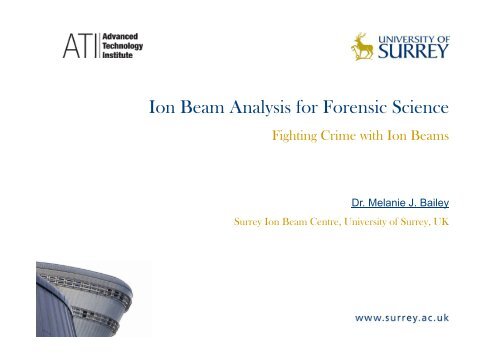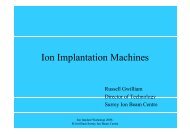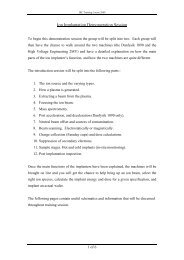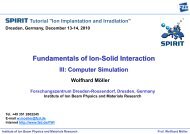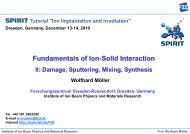Ion Beam Analysis for Forensic Science - SPIRIT
Ion Beam Analysis for Forensic Science - SPIRIT
Ion Beam Analysis for Forensic Science - SPIRIT
You also want an ePaper? Increase the reach of your titles
YUMPU automatically turns print PDFs into web optimized ePapers that Google loves.
<strong>Ion</strong> <strong>Beam</strong> <strong>Analysis</strong> <strong>for</strong> <strong>Forensic</strong> <strong>Science</strong><br />
Fighting Crime with <strong>Ion</strong> <strong>Beam</strong>s<br />
Dr. Melanie J. Bailey<br />
Surrey <strong>Ion</strong> <strong>Beam</strong> Centre, University of Surrey, UK
Contents<br />
• Why use IBA techniques in <strong>for</strong>ensic science<br />
• Example 1: Gunshot residues<br />
• Example 2: Soil analysis<br />
• Example 3: PIXE in case work<br />
• Complementary IBA / SIMS<br />
• Example 4: Fingerprints<br />
• Conclusions
Contents<br />
• Why use IBA techniques in <strong>for</strong>ensic science<br />
• Example 1: Gunshot residues<br />
• Example 2: Soil analysis<br />
• Example 3: PIXE in case work<br />
• Complementary IBA / SIMS<br />
• Example 4: Fingerprints<br />
• Conclusions
Background : IBA in <strong>for</strong>ensics<br />
Industrial Collaborators:<br />
National Police Improvement Agency, Surrey Police, Scotland Yard, Merseyside Police,<br />
the Home Office, the <strong>Forensic</strong> <strong>Science</strong> Service, LGC <strong>Forensic</strong>s<br />
• IBA was used in the case of Markov and the poison umbrella in<br />
1979<br />
• Only a very small number of academic publications exist on this<br />
subject<br />
• IBA has been used only recently in UK casework (by Surrey)
Background : IBA in <strong>for</strong>ensics<br />
Courtesy of Steve Sugden, Harwell Consulting
Can <strong>Ion</strong> <strong>Beam</strong>s Be Useful in <strong>Forensic</strong>s<br />
Industrial Collaborators:<br />
National Police Improvement Agency, Surrey Police, Scotland Yard, Merseyside Police,<br />
the Home Office, the <strong>Forensic</strong> <strong>Science</strong> Service, LGC <strong>Forensic</strong>s<br />
• IBA was used in the case of Markov and the poison umbrella in<br />
1979<br />
• Only a very small number of academic publications exist on this<br />
subject<br />
• IBA has been used only recently in UK casework (by Surrey)
What Do <strong>Forensic</strong> Analysts Need<br />
• Trace evidence analysis: establish<br />
provenance of material (e.g glass, paints,<br />
fibres) on a suspect or found at crime scene<br />
• <strong>Analysis</strong> techniques <strong>for</strong> trace evidence that<br />
are<br />
• Non-destructive<br />
ti<br />
• Accurate / reproducible<br />
• Highly discriminating<br />
• Need no sample preparation
<strong>Ion</strong> <strong>Beam</strong> <strong>Analysis</strong><br />
RBS<br />
Energy of scattered protons or He give<br />
light element composition and elemental<br />
depth profiles<br />
MeV protons<br />
or He<br />
Sample<br />
PIXE<br />
Characteristic i X-ray emission<br />
i<br />
Simultaneous part-per-million<br />
detection of trace elements from<br />
Na to U<br />
PIGE/NRA<br />
Nuclear reactions give characteristic<br />
gamma rays and/or particles from light<br />
nuclei (e.g. Li, B, F)<br />
IBIL<br />
<strong>Ion</strong> beam induced<br />
luminescence
Particle Induced X-ray Emission<br />
•Analogous to SEM-EDX EDX but using MeV protons or He<br />
•In<strong>for</strong>mation is from femtograms of material<br />
•Imaging resolution determined by beam size<br />
•Fully quantitative and absolute<br />
Courtesy of T. Calligro, C2RMF, France<br />
•Detection of Na to U<br />
•ppm sensitivity<br />
Intensit ty (log scale e)<br />
Mo<br />
Si<br />
Ca<br />
Fe<br />
Cu<br />
Se<br />
As<br />
Mo<br />
X Ray Energy (KeV)
Particle Induced Gamma-ray Emission<br />
• MeV protons can tunnel through the Coulomb barrier<br />
of light nuclei to induce gamma-emitting g nuclear<br />
reactions<br />
• Gamma energy is characteristic of specific isotopes<br />
• Detection limits ~ 10-100ppm<br />
• Useful <strong>for</strong> light elements: Al, F, Li, B, Na, Mg<br />
• Sharp resonances in the excitation function can be<br />
used <strong>for</strong> depth profiling<br />
^3 f:\pc_users\jpn\971118\490001g4._ : Tourmaline std: GRR573<br />
^2<br />
F<br />
F<br />
Li<br />
B Al Al<br />
Na<br />
^1<br />
^0<br />
Tourmaline standard<br />
GRR573<br />
100 300 500 700 900 1100 1300 1500 1700
Ruther<strong>for</strong>d Backscattering Spectrometry<br />
• Energy of ions scattering from nuclear collisions<br />
depends on mass and depth<br />
• Depth profiling with depth resolution
<strong>Ion</strong> <strong>Beam</strong> Induced Luminescence<br />
• Analogous to cathodoluminescence on SEM (CL)<br />
• Visible light emitted under ion impact<br />
• Yields chemical in<strong>for</strong>mation :<br />
– Impurities<br />
– Structural defects<br />
– Valence states<br />
Malquvist et al: NIMB 109/110 (1996) 337-233<br />
Courtesy of S. Calusi, INFN Firenze, Florence, Italy
Why Use <strong>Ion</strong> <strong>Beam</strong>s in <strong>Forensic</strong>s<br />
• <strong>Analysis</strong> does not destroy the samples<br />
• Very high sensitivity to trace elements<br />
• Fully quantitative and absolute<br />
• <strong>Analysis</strong> can take place in air or in vacuum<br />
• Can produce elemental maps on a sub<br />
micron scale<br />
• Most samples do not need any preparation<br />
treatments prior to analysis
What Do <strong>Forensic</strong> Analysts Need<br />
• Comparison of particles found on suspect with<br />
particles found at crime scene<br />
• <strong>Analysis</strong> techniques es <strong>for</strong> trace evidence such<br />
as glass, paints, fibres, soils that are<br />
• Non-destructive<br />
• Accurate / reproducible<br />
• Highly discriminating<br />
• Need no sample preparation<br />
a
Contents<br />
• Why use IBA techniques in <strong>for</strong>ensic science<br />
• Example 1: Gunshot residues<br />
• Example 2: Soil analysis<br />
• Example 3: Glass analysis<br />
• Complementary IBA / SIMS<br />
• Example 4: Fingerprints<br />
• Conclusions
The Gunshot Residue Problem in <strong>Forensic</strong>s<br />
Gunshot residue (GSR) particles :<br />
primer, bullet, bullet jacket,<br />
cartridge casing, gun barrel
Uniqueness of GSR<br />
LGC <strong>Forensic</strong>s (UK) :<br />
Classification of<br />
gunshot residue into 5<br />
different types using<br />
SEM-EDS elemental<br />
composition
Gunshot Residue in UK Casework
SEM-EDSEDS<br />
• Technique of choice <strong>for</strong> GSR analysis<br />
• Imaging of GSR<br />
• Automated analysis of GSR<br />
• Cheap
PIXE and SEM-EDS EDS <strong>for</strong> GSR <strong>Analysis</strong><br />
Residue No. of GSR Firearm Ammunition<br />
Reference particles<br />
studied<br />
Residue 1 12 Ruger Old Army 45<br />
Pistol<br />
Residue 2 8 Franchi 12 bone<br />
Semi Automatic<br />
Shotgun<br />
Pyrodex powder<br />
and Perdesol bullet<br />
Rottweil 12 cal<br />
70mm Dynamite<br />
Nobel<br />
Residue 3 11 Marlin 357 Gallery<br />
Magtech 357<br />
Rifle<br />
Cowboy Action<br />
Loads<br />
Residue 4 8 Parker Hale Rifle Radwell Green<br />
7.62mm, 155gr<br />
Samples were collected on an SEM stub with a high purity C sticky pad
SEM-EDS results<br />
K<br />
Cu<br />
S<br />
Fe<br />
•Small differences in K, Cu, S and Fe<br />
•All detected close to the detection limit (at%)<br />
•Non-quantitative technique<br />
F ll i t th b d t f f i<br />
•Fall into the same broad category as far as <strong>for</strong>ensics<br />
providers are concerned (Pb:Ba:Sb)
PIXE<br />
2.5 MeV protons, SiLi 50mm 2 detector with 130um Be filter<br />
• Particles studied by EDS were located using a Cu finder grid<br />
• Backscattered particle image and Pb signal was used to image particles<br />
• 10 minute point spectra (on average) were recorded<br />
d<br />
BSE image analogue
PIXE and EDX spectra<br />
100000<br />
Cu K<br />
Pb L<br />
10000<br />
1000<br />
Sn K<br />
100<br />
Sb K<br />
10<br />
Fe K<br />
1<br />
0 500 1000 1500 2000 2500 3000<br />
M J Bailey, K Kirkby and C Jeynes, J. X Ray Spec, accepted Dec 2008, DOI<br />
10.1002/xrs.1142
PIXE<br />
K Cl Ca Ni Sn<br />
•PIXE detects additional differences in Ni, Cl, Ca, Zn and Sn which<br />
are not detected by EDS<br />
•These differences are well above the detection limit (at% cf ppm)
Accurate Quantification of GSR particles by PIXE/RBS<br />
M J Bailey and C Jeynes, 10.1016/j.nimb.2009.03.031 (2008)<br />
• Fitted RBS spectrum<br />
• Fitted PIXE data<br />
• Fitted depth profile<br />
• Quantitative analysis<br />
possible by PIXE/RBS<br />
C substrate<br />
GSR<br />
particle
Work in Progress....<br />
• Round robin project with LGC <strong>Forensic</strong>s and police <strong>for</strong>ces from<br />
across the UK to characterise GSR from different sources<br />
• PIXE will be used to determine to what extent GSR can be further<br />
sub-categorised.
Contents<br />
• Why use IBA techniques in <strong>for</strong>ensic science<br />
• Example 1: Gunshot residues<br />
• Example 2: Soil analysis<br />
• Example 3: PIXE in case work<br />
• Complementary IBA / SIMS<br />
• Example 4: Fingerprints<br />
• Conclusions
Quartz Grain Texture <strong>Analysis</strong><br />
R Morgan and P Bull, University of Ox<strong>for</strong>d / Jill Dando Institute <strong>for</strong> Crime <strong>Science</strong><br />
• Frequently used in UK casework<br />
• Quartz grains used to provenance soil particles<br />
recovered from <strong>for</strong>ensic investigations<br />
• Texture of the quartz is studied by SEM<br />
• Different quartz grains have different textures<br />
depending on:<br />
• the parent rock<br />
• subsequent processes
Quartz Grain Texture <strong>Analysis</strong><br />
Examples....<br />
Grain type I<br />
“Well rounded grain with impact features (caused<br />
by river transportation) and subsequent grain<br />
surface solution (caused by soil acids<br />
following deposition)”<br />
Grain type II<br />
“Very angular grain with no edge abrasion<br />
(derived from a rock comprising of angular<br />
grains) with crystal growths on the surface of<br />
the grain (diagenetic features <strong>for</strong>med when<br />
the nearby sandstone had been turned into<br />
rock millions of years ago)”
Why use PIXE<br />
• Need an independent technique to verify conclusions<br />
• PIXE gives completely independent in<strong>for</strong>mation to quartz<br />
texture t analysis (elemental l cf topographical)<br />
• PIXE is more sensitive to trace elements than SEM-EDX<br />
and mapping is quicker
Can PIXE be used to identify different<br />
Can PIXE be used to identify different<br />
provenances (grain types) of quartz
Sample 3:<br />
“Mixed” Sample 1:<br />
2 grain types<br />
“Pure”<br />
Quartz<br />
Sample 2:<br />
“Real”<br />
1 grain type
How reproducible is the technique<br />
Typical PIXE maps from sample 1 Typical PIXE maps from sample 2
How reproducible is the technique<br />
1000000<br />
1000000<br />
100000<br />
100000<br />
Concentra ation (ug/g)<br />
10000<br />
1000<br />
100<br />
10<br />
grain 1<br />
grain 2<br />
grain 3<br />
grain 4<br />
grain 5<br />
ion (ug/g)<br />
Concentrat<br />
10000<br />
1000<br />
100<br />
10<br />
grain 1<br />
grain 2<br />
grain 3<br />
grain 4<br />
grain 5<br />
grain 6<br />
grain 7<br />
grain 8<br />
grain 9<br />
grain 10<br />
1<br />
Si P S Cl K Ca Ti Cr Mn Fe Cu Zn Rb Sr Ba<br />
1<br />
Si P S Cl K Ca Ti Cr Mn Fe Cu Zn Rb Sr Ba Zr<br />
Sample 1 Sample 2<br />
• There is a clear distinction between sample 1 and<br />
sample 2<br />
• The grain to grain variability is demonstrated
Typical PIXE maps <strong>for</strong> Sample 3 “Mixed” (two grain types)<br />
Two major classes of map:<br />
Either:<br />
Or:<br />
+Sr, Ba and Rb<br />
+ luminescence
Can we distinguish i i one source from another<br />
100000<br />
10000<br />
(ug/g)<br />
Fe<br />
1000<br />
100<br />
Mixed<br />
Real<br />
Pure Quartz<br />
10<br />
1<br />
1 10 100 1000 10000 100000<br />
Ca (ug/g)
Can we distinguish i i one source from another<br />
100000<br />
10000<br />
(ug/g)<br />
Fe<br />
1000<br />
100<br />
Mixed<br />
Real<br />
Pure Quartz<br />
10<br />
1<br />
1 10 100 1000 10000 100000<br />
Ca (ug/g)
Work in Progress<br />
• Quartz grains from previous murder investigations will be studied<br />
d<br />
using<br />
– PIXE<br />
– PIGE<br />
– IBIL<br />
– Mapping to study the microstructure
Contents<br />
• Why use IBA techniques in <strong>for</strong>ensic science<br />
• Example 1: Gunshot residues<br />
• Example 2: Soil analysis<br />
• Example 3: PIXE in case work<br />
• Complementary IBA / SIMS<br />
• Example 4: Fingerprints<br />
• Conclusions
PIXE in casework<br />
• June 2008, Surrey IBC<br />
• Document from a murder investigation<br />
• External beam PIXE used to establish the age of the document<br />
• i.e. was it current (>2006) or old (c1960)
PIXE in casework<br />
• The paper<br />
contains many<br />
impurities<br />
• Note in<br />
particular S, K,<br />
Ba, Pb, Rb
PIXE in casework<br />
• A previous study of newspaper<br />
from three different dates by<br />
XRF<br />
• Earlier paper contained a<br />
greater concentration of<br />
impurities<br />
• In modern day paper, Pb, Ba,<br />
S, K and Rb should not be<br />
present<br />
Concentration (μg g -1 )<br />
1919<br />
100000<br />
1941<br />
2005<br />
10000<br />
1000<br />
100<br />
10<br />
1<br />
S K Ca Ti Mn Fe Cu Zn Ga As Rb Sr Ba Pb<br />
Manso et al (Nucl. Instr. Meth. Res. B, 580 (2007), 732-734)
Contents<br />
• Why use IBA techniques in <strong>for</strong>ensic science<br />
• Example 1: Gunshot residues<br />
• Example 2: Soil analysis<br />
• Example 3: PIXE in case work<br />
• Complementary IBA / SIMS<br />
• Example 4: Fingerprints<br />
• Conclusions
Secondary <strong>Ion</strong> Mass Spectrometry<br />
• Primary ion beam (KeV or MeV) is used to sputter target material<br />
• Secondary ions are analysed in mass spectrometer<br />
• Surface mass spectrometry<br />
• High sensitivity– ppb<br />
• Molecular specificity<br />
• Quantification difficult
Example 4 : Fingerprint <strong>Analysis</strong> by SIMS (secondary<br />
ion mass spectrometry)<br />
Thames Valley Police, Scotland Yard + Steve e Hinder and John Watts – University of Surrey
SIMS Imaging of Fingerprints<br />
i<br />
• Fingerprints are still used in police<br />
investigations<br />
• To back up DNA evidence<br />
• Where it cannot be used<br />
• Can we obtain chemical in<strong>for</strong>mation from<br />
fingerprints<br />
• Smoker<br />
• Diet<br />
• Cosmetics
Can We Detect Moisturiser i in Fingerprints i Nivea <strong>for</strong> Men : Moisturiser<br />
Glycerin; sugar-alcohol of varied use<br />
Na Laureth sulphate; detergent/surfactant used widely in personal care products.<br />
Tocopheryl acetate; vitamin E acetate used in skin creams<br />
Bisabolol; fragrance, has perceived skin care properties.<br />
PEG-7 glyceryl cocoate; fatty acid mixture from coconuts<br />
Xanthan Gum; polysaccharide chain used as rheology modifier<br />
Benzophenone; UV blocker<br />
Phenoxyethanol; range of properties, often found in skin creams<br />
Parabens; Methyl, Ethyl, Propyl & Butyl : used as an antifungal preservative.<br />
Na carbomer.<br />
Na methyl cocoyl taurate.<br />
Farnesol; perfume/flavouring agent<br />
Imaged molecule : polyethylene terephthalate (PET)<br />
Substrate : poly(vinylndene difluoride) (PVdF)
C 3 F 4 H +<br />
Green = fingerprint<br />
149 m/z<br />
C +<br />
3 F 5 H<br />
Blue = PVdF topcoat<br />
197 m/z<br />
Substrate (PVdF) Moisturiser (PET)
Fingerprint i <strong>Analysis</strong> Using MeV SIMS<br />
• 10 MeV O4+ TOF SIMS, 4 micron beam<br />
• Nivea <strong>for</strong> women<br />
Fingerprint<br />
600<br />
H + 500<br />
300<br />
400<br />
200<br />
100<br />
0<br />
0 100 200 300 400 500
Future Prospects<br />
• MeV SIMS : in air analyses<br />
• Will allow larger molecular fragments to be imaged – i.e. chemical<br />
in<strong>for</strong>mation from fingerprints<br />
• Can we develop fingerprints on difficult surfaces<br />
– Patterned surfaces : e.g. money<br />
– Reagent development issues : covert analyses<br />
• Can we use SIMS/MeV SIMS to detect the sequencing of fingerprint<br />
/i ink
Conclusions<br />
• PIXE / PIGE / RBS / IBIL can be carried out simultaneously and are<br />
highly discriminating compared with other non-destructive<br />
techniques.<br />
• Work is in progress to establish the use of these techniques in police<br />
casework<br />
• SIMS / MeV SIMS are useful techniques <strong>for</strong> new types of fingerprint<br />
analysis
Ak Acknowledgements ld<br />
Surrey IBC Staff<br />
Chris Jeynes<br />
Karen Kirkby<br />
Geoff Grime<br />
Matt Christopher<br />
Jill Dando Institute <strong>for</strong> Crime <strong>Science</strong><br />
Ruth Morgan<br />
NPIA and Surrey Police<br />
John Armstrong<br />
Martin Hanly<br />
Scotland Yard<br />
Gary Pugh<br />
LGC <strong>Forensic</strong>s<br />
Chris Moynehan<br />
Ox<strong>for</strong>d University<br />
Peter Bull
Thank you


